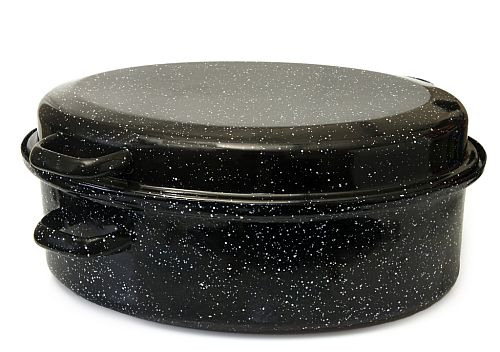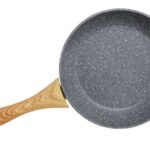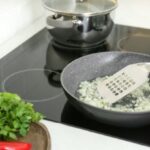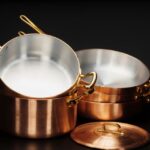What Is Graniteware Cookware Made Of?
Graniteware is a type of enamelware and also a brand name.
“Graniteware” is a term widely used in the enamelware collecting community that refers to enamelware produced from the 1870s through the end of World War II. The older graniteware pieces were made of tin or iron. They had more layers of glass coating and were heavier compared to modern kitchen items. Granite cookware quickly became popular due to the practical glass surface combined with the strength of the metal. The shiny porcelain surface was easier to maintain than heavy, rust-prone cast iron parts.
Granite kitchen utensils have nothing in common with granite, except the appearance. Nowadays, kitchen items are made from granite with a steel core and a glass coating. Porcelain enamel is fused with metal at 2,000 F, creating a non-porous, inert, and non-stick glass surface. The granite items made today are thinner and lighter than what Grandma used to make.

Is the Graniteware Safe for Cooking?
Modern Graniteware is made of thin carbon steel covered with a layer of porcelain enamel. The glass coating is inert and free of harmful chemicals. It does not interact with food or change the taste or color of your meals. If the porcelain coating is not damaged, Graniteware cookware is suitable for cooking and storing all varieties of foods, including acidic meals. If there is a chip on the outside of the cookware, it does not affect the safety or cooking ability of the item. However, if the coating on the inside peels off, you may no longer use the cookware for food preparation and storage.
What Can You Cook in a Graniteware Roaster
Today’s GraniteWare roasters are thinner and less sturdy compared to older models. Some cheaper models are thin and flimsy and may have sharp edges that are not securely finished. But most of these roasters are still good enough to cook your Thanksgiving turkey to perfection or bake your own “artisan” bread. These pans are perfect for preparing large meals and can be used for all types of foods that you can fry in the oven.
Advantages:
- The inner carbon steel core distributes heat evenly and quickly.
- The dark porcelain surface absorbs heat quickly, lowering cooking times.
- The products are lightweight and much easier to handle than comparable cast-iron items.
- You can cook meals in the oven without any mess.
- The smooth glass surface allows for easy cleaning.
- The food comes out tender and delicious.
- Affordable prices make this cookware a good choice for budget-conscious customers.
Disadvantages:
- This cookware cannot be used on stoves with glass surfaces as these may damage the hob.
- Modern graniteware is too thin to retain heat well.
- Thin-layer granite dishes are prone to chipping, especially if dropped.
- Despite the manufacturer’s claim that the surface is non-stick, many users experience sticking issues. I often end up with burnt food on the bottom and sides of my granite roaster. However, the burnt residue can be easily removed if you leave the pan in the sink and soak it in soapy water.
- Some buyers find today’s graniteware kitchenware too ordinary and unattractive.
Cleaning and Care
- The impervious surface makes this cookware easy to clean. According to the manufacturer, most granite roasters are dishwasher safe, but can also be easily cleaned by hand with soap and water.
- To remove the burnt juices, fill the pan with warm soapy water and let it sit for a few hours.
- Make sure you wear gloves when washing to avoid cuts on sharp edges.
- Do not heat the roaster when it is empty.
- To avoid splintering, do not drop the roaster on hard surfaces.
- Store the cookware by turning the lid over and placing it on the roasting pan. When storing roasting pans by stacking them, place a tea towel between the lid and the pan to prevent splintering.
Related product: Granite Ware Enamel on Steel 21 in. Covered Rectangular Roaster (Amazon)




does graniteware really shatter glass top electric stoves? I just purchased a set and the salesman never mentioned that what do I do?
Will granite ware work well on Magnetic stoves?
Only cookware items that have a completely flat bottom. I would consider some other brands for cooking on an induction stove.
I used Granite Ware turkey roaster for the first time following the instructions on the bag the turkey came in roast at 325. Needless to say my turkey was done a hour earlier. I was not happy how it turned out. It was a 12 pound turkey and was a little dry. I have an electric stove. What temperature should I use next time with Granite Ware??